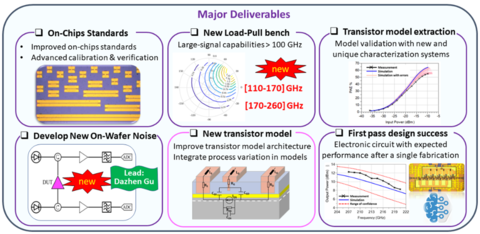Summary
Advanced semiconductor technology has led to continuous performance improvements in transistors. However, many iterations are needed to obtain optimal performance and the yield and reproducibility is incredibly poor. Furthermore, US chip makers are currently ill-equipped with legacy measurement techniques and underperforming models.
This project will improve the state-of-the-art in the modeling, design, and fabrication of high-frequency circuits by analyzing the predictive performance of existing models, incorporating fabrication process variation into model responses, and validating models on realized circuits.
Grand Challenge 4: Modeling and Simulating Semiconductor Materials, Designs, and Components
Description

This figure illustrates the main project deliverables.
Due to the challenges of high-frequency measurements, that includes inaccuracy in on-wafer calibration and a lack of instrumentation for transistor characterization, models are currently extracted from low frequency measurements and extrapolated to higher frequencies. This methodology has been shown to be inadequate for millimeter-wave circuit designs. Novel on-wafer calibration and transistor characterization approaches must be developed to extract robust models and to highlight potential limitations in their ability to accurately replicate the actual performance of the transistors.
On the consumer market side, rapid development in transistor technology has resulted in unwavering improvement of transistor sensitivity. These transistors are integrated in transceivers and played key roles in emerging applications, such as Internet of Things, Satellite Internet Service Providers, high-speed communication and defense systems. Existing measurement techniques can no longer keep up with qualifying ultra-low noise transistors. Semiconductor companies are in a great need of modernizing transistor characterization of noise and other parameters and improving accuracy of transistor circuit models, in particular at high frequencies.
The success of this project represents a major step forward from conventional transistor characterization and model extraction and validation. It would bring a complete and unique overhaul of existing instrumentation and eliminate cumbersome hardware.
The US semiconductor companies can rely on the new instrumentation and measurement techniques to obtain device performance data with significantly improved accuracy. This data not only can provide qualification guidance for transistor manufacture for a better customer experience, but also can be utilized in the cost-effective circuit design cycle to further improve the transistor performance.

